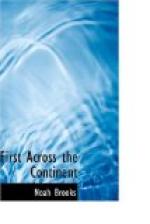“The mountains, which, from the great shoot to this place, are high, rugged, and thickly covered with timber, chiefly of the pine species, here leave the river on each side; the river becomes two and one-half miles in width; the low grounds are extensive and well supplied with wood. The Indians whom we left at the portage passed us on their way down the river, and seven others, who were descending in a canoe for the purpose of trading below, camped with us. We had made from the foot of the great shoot twenty-nine miles to-day. The ebb tide rose at our camp about nine inches; the flood must rise much higher. We saw great numbers of water-fowl, such as swan, geese, ducks of various kinds, gulls, plovers, and the white and gray brant, of which last we killed eighteen.”
Chapter XVII — From Tidewater to the Sea
Near the mouth of the river which the explorers named Quicksand River (now Sandy), they met a party of fifteen Indians who had lately been down to the mouth of the Columbia. These people told the white men that they had seen three vessels at anchor below, and, as these must needs be American, or European, the far-voyaging explorers were naturally pleased. When they had camped that night, they received other visitors of whom the journal makes mention:—
“A canoe soon after arrived from the village at the foot of the last rapid, with an Indian and his family, consisting of a wife, three children, and a woman who had been taken prisoner from the Snake Indians, living on a river from the south, which we afterward found to be the Multnomah. Sacajawea was immediately introduced to her, in hopes that, being a Snake Indian, they might understand each other; but their language was not sufficiently intelligible to permit them to converse together. The Indian had a gun with a brass barrel and cock, which he appeared to value highly.”




